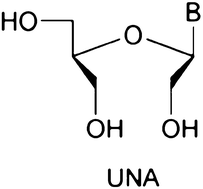Utilization of unlocked nucleic acid (UNA) to enhance siRNA performance in vitro and in vivo
Abstract

* Corresponding authors
a Department of Molecular Biology, Aarhus University, DK-8000 Aarhus, Denmark
b
Interdiciplinary Nanoscience Center, Aarhus University, DK-8000 Aarhus, Denmark
E-mail:
jebb@mb.au.dk
Fax: +45 8619 6500
Tel: +45 8942 2668
c Nucleic Acids Center, Department of Chemistry, University of Southern Denmark, DK-5230 Odense M, Denmark
d Macrozyme BV, Meibergdreef 45, 1105 BA Amsterdam, the Netherlands
e Dept of Neurogenetics, AMC, Meibergdreef 9, 1105 AZ Amsterdam, the Netherlands
f Ribotask ApS, Promonadebyen 2-8, DK-5000 Odense C, Denmark
g Department of Haematology, Aalborg Hospital, Aarhus University Hospital, DK-9000 Aalborg, Denmark

 Please wait while we load your content...
Something went wrong. Try again?
Please wait while we load your content...
Something went wrong. Try again?
M. B. Laursen, M. M. Pakula, S. Gao, K. Fluiter, O. R. Mook, F. Baas, N. Langklær, S. L. Wengel, J. Wengel, J. Kjems and J. B. Bramsen, Mol. BioSyst., 2010, 6, 862 DOI: 10.1039/B918869J
To request permission to reproduce material from this article, please go to the Copyright Clearance Center request page.
If you are an author contributing to an RSC publication, you do not need to request permission provided correct acknowledgement is given.
If you are the author of this article, you do not need to request permission to reproduce figures and diagrams provided correct acknowledgement is given. If you want to reproduce the whole article in a third-party publication (excluding your thesis/dissertation for which permission is not required) please go to the Copyright Clearance Center request page.
Read more about how to correctly acknowledge RSC content.
 Fetching data from CrossRef.
Fetching data from CrossRef.
This may take some time to load.
Loading related content
